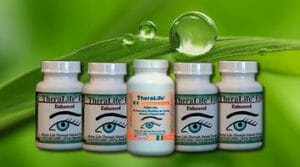Are you having more dry eyes because your smartphones?
Staring at a smart phone or computer screen can cause chronic dry eyes. Subsequently, many people do not realize the blue light that is emitted from a smart phone can also harm the eyes. But there is a natural treatment that will help your chronic dry eyes.
Statistics of eye damage from smartphones
Studies have shown that 60% of people spend at least 6 hours a day in front of a digital screen. Meanwhile, blue light is emitted from these types of screens harming your eyes.
Why is Blue Light Harmful to the Eyes?
There are visible and non-visible light waves. The visible light spectrum is what allows us to see colors. A rainbow is proof of this range of colors: red, orange, yellow, green, blue, indigo, and violet.
Wave Length and Energy Levels.
This visible light is made up of electromagnetic particles that travel in waves. Likewise, these waves vary in energy levels, range, length, and strength. This means, the longer the wavelength, the lower the energy; the shorter the wavelength, the higher the energy. Because blue light has a very short wavelength, it produces a higher energy than other colors. In additon, studies have shown that prolonged exposure to blue light causes serious and long-term damage to the eyes.
Where is Blue Light Found?
Blue light is everywhere: outside from the sun, inside from appliances such as TVs, computers, smart phones, electronic devices, LED and fluorescent lighting. Certainly avoiding blue light is simply not possible.
Blue light waves flicker more easily because of their strong, short wavelength. Subsequently, this flickering can cause glaring, eyestrain, headaches, and mental fatigue from computer screens and other electronic device.
What kind of damages from blue light to eyes that result in dry eyes?
The eyes have natural filters to protect against strong light waves. However, the eyes do not provide sufficient protection against blue light rays from smart phones or fluorescent-light tubes. Therefore, retinal damage occurs with prolonged exposure to blue light. In addition, vision loss is accelerated from blue light exposure in age-related macular degeneration.
Why is Smartphones Technology Responsible for dry eyes?
Many of the electronic devices today use LED back-light technology. Because this technology gives the viewer a clearer and brighter screen. However, the LEDs that are emitted from these devices are very strong blue light waves. The public is gradually being exposed to additional sources of blue light for longer periods of time which gives rise to dry eyes.
What are the eye strain symptoms?
Digital eye strain is a big concern for those who spend endless hours exposed to LED blue light waves. Digital eyestrain and dry eyes symptoms include:
- Blurry vision
- Difficulty focusing
- Dry and irritated eyes
- Headaches
- Neck pain
- Back pain
Both adults and children are at risk for digital eyestrain. Similarly, children as young as 4 years old are using cell phones regularly now. In addition, working adults must have the knowledge of computers for employment.
What are the permanent damages to the eye?
Medical evidences shows that extensive exposure to blue light may cause permanent eye damage. This is because blue light destroys the retina, and cause vision loss through age-related macular degeneration.
A recent Harvard medical study stated that High Energy Visible (HEV) blue light is the most dangerous light for the retina. In short, those who are chronically exposed to blue light can expect to see an increase macular degeneration, glaucoma, and retinal degenerative diseases.
Help with Chronic Dry Eyes
Everyone needs protection from blue light exposure. In short, limiting the number of hours staring at a computer screen, texting on a cellphone, time spent outdoors with unprotected eyes can help reduce dry eyes and vision problems.
What is the traditional dry eyes relief?
Traditional dry eye relief is eye drops. But eye drops can make your eyes drier when used frequently. In addition, eye drops can wash off the natural lubricants your eyes produce.
Therefore, for a more sustainable, longer lasting dry eyes relief, try oral dry eye treatment. TheraLife can help.
How is TheraLife different?
The entire line of TheraLife products helps to restore, revive and protective the eyes from the inside out. TheraLife uses only natural products and believes that allowing the body to restore itself is the best way to have healthy, pain-free eyes.
Call toll free 1-877-917-1989 from US/Canada, International (650) 949-6080
Visit www.theralife.com





